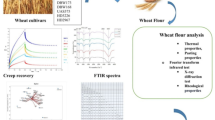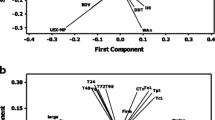Abstract
White, yellow and purple maize flours were obtained after dried kernels milling with two different sieves (200 and 500 μm). Hygroscopic characteristics, particle size distribution, colour and total starch and damaged starch (DS) of flours were determined. Maize flour doughs were obtained by mixing of flour and water in a laboratory kneader (Mixolab®) at constant dough consistency (1.10 ± 0.07 Nm). Dough properties like water absorption (WA), development and stability times were determined. Rheological characterization was carried out at 30 °C by means of oscillatory frequency sweep (1–100 rad s−1) at 0.1 % strain and creep (50 Pa, 60 s) - recovery (0 Pa, 180 s) tests using a controlled stress rheometer. No significant differences were observed among water desorption isotherms of maize varieties and Halsey model was satisfactorily employed. Under the same milling conditions, white maize flours showed higher average particles size than purple and yellow maize flours. A model to predict flours colour involving colour parameters of the particle size fractions is proposed. Flours obtained with smaller particle size showed higher DS content and WA. For tested doughs, the mechanical spectra showed that elastic component was dominant over the viscous one. Damping factor varied slightly with angular frequency. Moduli values depended on average particle size and WA of dough. Creep-recovery data were satisfactorily fit with Burgers model. Instantaneous creep compliance varied with the same trend than elastic modulus. Viscoelastic creep compliance increased linearly with WA of the tested doughs and, at constant average flour particle size, increased with increasing DS.



Similar content being viewed by others
References
AACC, American Association of Cereal Chemists (2000) Approved methods of the AACC. 10th Methods, St. Paul
AOAC, Association of Official Analytical Chemists (1995) Official methods of analysis, Washington
Bolade MK, Adeyemi IA, Ogunsua AA (2009) Influence of particle size fractions on the physicochemical properties of maize flour and textural characteristics of a maize-based nonfermented food gel. Int J Food Sci Technol 44:646–655
Burgers JM (1935) First report on viscosity and plasticity. Nordemann Pub, New York
Collar C, Bollaín C, Rosell CM (2007) Rheological behaviour of formulated bread doughs during mixing and heating. Food Sci Technol Int 13:99–107
Collar C, Balestra F, Ancarani D (2014) Value added of resistant starch maize-based matrices in breadmaking: nutritional and functional assessment. Food Bioprocess Technol 7:3579–3590
Doymaz I, Pala M (2003) The thin–layer drying characteristics of corn. J Food Eng 60:125–130
Escribano-Bailón MT, Santos-Buelga C, Rivas-Gonzalo JCR (2004) Anthocyanins in cereals. J Chromatogr A 1054:129–141
FAO (2015) http://faostat.fao.org/site/567/default.aspx#ancor (updated: 04 August 2014)
Flores-Silva PC, Berrios JJ, Pan J, Osorio-Díaz P, Bello-Pérez LA (2014) Gluten-free spaghetti made with chickpea, unripe plantain and maize flours: functional and chemical properties and starch digestibility. Int J Food Sci Technol 49:1985–1991
Greer EN, Stewart BA (1959) The water absorption of wheat flour: relative effects of protein and starch. J Sci Food Agric 10:248–255
Gwirtz JA, García-Casal MN (2014) Processing maize flour and corn meal food products. Ann N Y Acad Sci 1312:66–75
Hadnadev TD, Torbica A, Hadnađev M (2011) Rheological properties of wheat flour substitutes/alternative crops assessed by Mixolab. Proc 11th International Congress on Engineering and Food (ICEF11) 1:328–334
Hadnadev TD, Pajic-Lijakovic I, Hadnadev M, Mastilovic J, Torbica A, Bugarski B (2013) Influence of starch sodium octenyl succinate on rheological behaviour of wheat flour dough systems. Food Hydrocoll 33:376–383
Halsey G (1948) Physical adsorption on non-uniform surfaces. J Chem Phys 16:931–937
ICC (2008) ICC-standard methods. International Association for Cereal Chemistry, Vienna
Jing P, Bomser JA, Schwartz SJ, He J, Magnuson BA, Giusti MM (2008) Structure-function relationships of anthocyanins from various anthocyanin-rich extracts on the inhibition of colon cancer cell growth. J Agric Food Chem 56:9391–9398
Kuhnen S, Lemos PMM, Campestrini LH, Ogliari JB, Dias PF, Maraschin M (2011) Carotenoid and anthocyanin contents of grains of Brazilian maize landraces. J Sci Food Agric 91:1548–1553
Lazaridou A, Duta D, Papageorgiou M, Belc N, Biliaderis CG (2007) Effects of hydrocolloids on dough rheology and bread quality parameters in gluten-free formulations. J Food Eng 79:1033–1047
Li LT (1998) The color of food and its optical properties. In: Mingxi P, Lijun D (eds) Physical properties of food. China Agricultural Press, China, p. 324
Li E, Dhital S, Hasjim J (2014) Effects of grain milling on starch structures and flour/starch properties. Starch/Stärke 66:15–27
Malumba P, Boudry C, Roiseux O, Bindèlle J, Beckers Y, Béra F (2015) Chemical characterisation and in vitro assessment of the nutritive value of co-products yield from the corn wet-milling process. Food Chem 166:143–149
Marco C, Rosell CM (2008) Breadmaking performance of protein enriched, gluten-free breads. Eur Food Res Technol 227:1205–1213
Moreira R, Chenlo F, Torres MD, Prieto DM (2010) Influence of the particle size on the rheological behaviour of chestnut flour doughs. J Food Eng 100:270–277
Moreira R, Chenlo F, Torres MD, Prieto DM (2012) Technological assessment of chestnut flour doughs regarding to doughs from other commercial flours and formulations. Food Bioprocess Technol 5:2301–2310
Moreira R, Chenlo F, Torres MD (2013a) Rheology of gluten-free doughs from blends of chestnut and rice flours. Food Bioprocess Technol 6:1476–1485
Moreira R, Chenlo F, Torres MD, Rama B (2013b) Influence of the chestnuts drying temperature on the rheological properties of their doughs. Food Bioprod Process 91:7–13
Pruska-Kedzior A, Kedzior Z, Goracy M, Pietrowska K, Przybylska A, Spychalska K (2008) Comparison of rheological, fermentative and baking properties of gluten free dough formulations. Eur Food Res Technol 227:1523–1536
Revilla P, Landa A, Rodríguez VM, Romay MC, Ordás A, Malvar RA (2008) Maize for bread under organic agriculture. Span J Agric Res 6:241–247
Rosell CM, Collar C, Haros M (2007) Assessment of hydrocolloid effects on the thermo-mechanical properties of wheat using the mixolab. Food Hydrocoll 21:452–462
Sandhu KS, Singh N, Malhi NS (2007) Some properties of corn grains and their flours. I: physicochemical, functional and chapati-making properties of flours. Food Chem 101:938–946
Sivaramakrishnan HP, Senge B, Chattopadhyay PK (2004) Rheological properties of rice dough for making rice bread. J Food Eng 62:37–45
Steffe JF (1996) Rheological methods in food process engineering, 2nd edn. Freeman Press, East Lansing
Watson SA (1987) Structure and composition corn, chemistry and technology. AACC, St. Paul, pp. 53–82
Wolf W, Spiess WEL, Jung G (1985) Standardization of isotherm measurements (cost-project 90). In: Simatos D, Multon JL (eds) Properties of water in foods. Martinus Nijhoff, Dordrecht, pp. 661–679
Yang Z, Han Y, Gu Z, Fan G, Chen Z (2008) Thermal degradation kinetics of aqueous anthocyanins and visual color of purple corn (Zea mays L.) cob. Innov Food Sci Emerg 9:341–347
Acknowledgments
The authors acknowledge the financial support to Ministerio de Economía y Competitividad of Spain and FEDER (CTQ 2013-43616/P).
Author information
Authors and Affiliations
Corresponding author
Additional information
Highlights
- Flour colour can be estimated from colour of its particle size fractions.
- Damaged starch decreases with particle size and affects to water absorption.
- Viscoelastic characteristics of flour doughs depend on water absorption.
- Rheology of dough depends on maize variety and average particle size of flour.
Rights and permissions
About this article
Cite this article
Moreira, R., Chenlo, F., Arufe, S. et al. Physicochemical characterization of white, yellow and purple maize flours and rheological characterization of their doughs. J Food Sci Technol 52, 7954–7963 (2015). https://doi.org/10.1007/s13197-015-1953-6
Revised:
Accepted:
Published:
Issue Date:
DOI: https://doi.org/10.1007/s13197-015-1953-6




